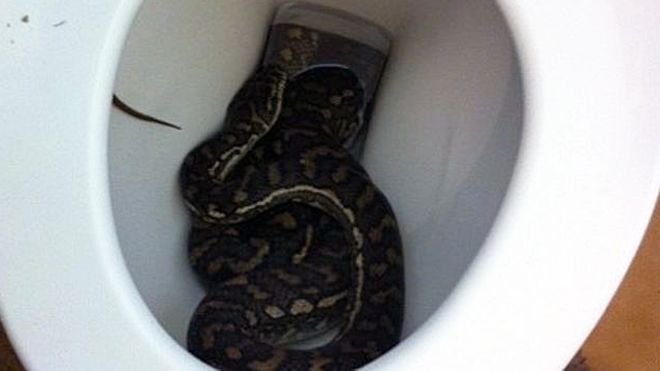- 28 May 2016
- Magazine
 GEOFF JACOBS
GEOFF JACOBS
A man in Thailand got a shock this week when he went to the toilet and a python sank its teeth into his penis. What animals can navigate the sewers to pop up in your loo, asks Alison Gee.
Attaporn Boonmakchuay's encounter with the 3m (10ft) python happened at his home east of Bangkok as he was getting ready for work one morning. "I felt as though my penis had been severed. The snake was yanking very hard," he said, according to the Bangkok Post.
The python had slithered through the plumbing and up into his toilet.
Stories of snakes navigating domestic plumbing are quite common, says Geoff Jacobs at Queensland Wildlife Solutions in Australia, who has run a snake-catching business in Brisbane for 20 years.
"The snakes just follow the trail of the rats," he says. "All over the world rats go down in sewers and the snakes go in there after them." And from there they can find your bathroom.
"There's only a small amount of water in the bottom of your toilet bowl. They come up through a dry pipe and there's a small bit of water in the S-bend - he's only got to go down an inch-and-a-half or two inches and straight back up, so its quite easy once they learn how to do it," says Jacobs.
He gets called out to remove at least four or five snakes from toilets each year- usually green tree snakes, common tree snakes or carpet pythons.
"It's the worst job. You get a toilet bowl that's been there 30 or 40 years - we see the bit that gets cleaned but the rest of it doesn't. When you go to pull the thing out of there, it's not fun. I usually have a bottle of disinfectant with me," he says. "You've got to grab the head or whatever you can get hold of and start dragging it out."
 THINKSTOCK
THINKSTOCK
Even if you live in a place where snakes are rare, there are always rats to consider.
"It was probably about three or four o'clock in the morning. I was in bed," says Tansy Aked, telling the story of an unpleasant experience that occurred in a basement flat in the desirable Maida Vale area of west London.
"I heard splashing noises - quite loud splashing noises, like something was in the bath.
"For some reason I had it in my head that there was a frog in the bath. I think that was because I was half asleep. So I stumbled into the bathroom and realised it wasn't a frog in the bath but a rat splashing around in the loo.
"The seat was down so it couldn't get out but it was scrabbling around. So I slammed the lid down in fear and I flushed the loo, and he flushed away."
Aked went back to bed, but an hour later the splashing started again. "So I flushed him away again," she says.
In the morning she opened the cupboard under the sink and realised rats had been in there too. She could still hear them "scuttling behind the skirting boards" so she rang the rat catcher who offered to come straight away, in an unmarked car so as not to embarrass her in front of the neighbours.
He told her the rats must have got in through the sewer and he laid some poison, but warned that although it would kill this particular family of rodents, more could appear. By coincidence, Aked moved house a few weeks later so never found out if the problem persisted.
"The scary thing is it could have been swimming around in the pipe and you could have gone to the loo and then it could have popped up," she says.
Watch your posteriors!
People in County Cork, in the Republic of Ireland, were warned to check their toilets in April after an elderly man was bitten on the bottom by a rat.
A local councillor advised people "to keep their toilet seats down when not in use, and to watch their posteriors", reported the Cork Evening Echo.
It's thought that rats had entered the sewers through a broken pipe.
Dangerous spiders are another toilet hazard in some countries. Although he only deals with snakes, Jacobs says that funnel-webs can be a particular problem in Australia - not just dropping into the bowl from above but also approaching from beneath. "They can go either way," he says. "Many spiders can travel along under water."
While funnel-webs can't swim, the can stay alive in water for up to 30 hours. "They can trap a small bubble of air in hairs around the abdomen, which aids both breathing and floating," according to the Australian Museum's website.
In New York, stories of alligators in the sewers have proliferated since the 1930s, but they are probably just urban legends. In Paris, however, a crocodile was found in the city's sewers in the 1980s under Pont Neuf. There is no record though of an animal of this kind getting round a U-bend and arriving in a toilet.
Subscribe to the BBC News Magazine's email newsletter to get articles sent to your inbox.

No comments:
Post a Comment